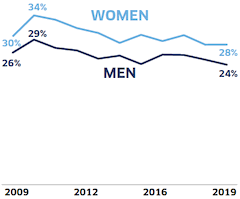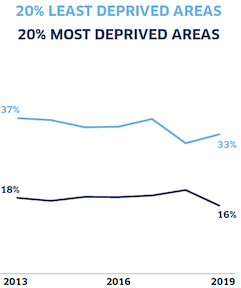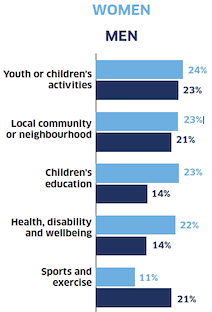Scottish household survey 2019: key findings
An infographic summary of the key findings from the 2019 edition of the Scottish Household Survey, a continuous survey running since 1999 based on a sample of the general population in private residences in Scotland.
Section Eleven - Volunteering
26% of adults in Scotland had taken part in formal volunteering in the last twelve months in 2019. This was a decrease from 31% in 2010.
Women were consistently more likely to undertake formal volunteering than men. In 2019, 28% of women undertook formal volunteering in the past month, while 24% of men were doing the same.
Levels of formal volunteering had decreased among both men and women since 2010, decreasing by 6 percentage points among women and 5 percentage points among men.

This line graph shows the proportion of men and women taking part in formal volunteering between 2009 and 2019. It highlights that since 2010, the proportion of both men and women partaking in formal volunteering had decreased.
Women aged 35 to 59 were the most likely to undertake formal volunteering
33% of this group undertook formal volunteering in the last twelve months in 2019
Adults in the least deprived areas in Scotland were more likely to undertake formal volunteering, with 33% of adults reporting having done so in last twelve months.
In comparison, 16% of adults in the most deprived areas undertook formal volunteering in the last twelve months.
While formal volunteering among adults living in the 20% most deprived areas in Scotland had remained consistent since 2013, formal volunteering in the least deprived areas decreased from 37% of adults in 2013 to 33% of adults in 2019.

This line graph shows the proportion of adults in the most and least deprived areas in Scotland taking part in formal volunteering, it highlights that more adults in the least deprived areas had taken part in formal volunteering in this period, but that these levels decreased between 2016 and 2019.
33% of adults in rural areas undertook formal volunteering
in comparison with 25% of adults in urban areas
Organisations that worked with youth or children activities outside school, or were engaged in the local community or neighbourhood were the most common to undertake formal volunteering with.
There were significant differences between men and women regarding the types of formal volunteering they normally undertook.
Women were significantly more likely to take part in formal volunteering with organisations that work with children’s education and health, disability and wellbeing.
Men were more likely to undertake formal volunteering with organisations related to physical activities, sports and exercise.

This bar chart lists the five most common types of formal volunteering, showing the proportion of men and women taking part in these activities. It lists the following types of formal volunteering, in order of how common they are: “Youth or children’s activities”, “Local community or neighbourhood”, “Children’s education”, “Health, disability and wellbeing”, and “Sports and Exercise”. It highlights that women were more likely to volunteer formally with organisations involved in children’s education and health, disability and wellbeing, while men are more likely volunteer formally with organisations involved with sports and exercise.
36% of adults in rural areas undertook formal volunteering with organisations involved with the local community or neighbourhood
Contact
Email: shs@gov.scot
There is a problem
Thanks for your feedback